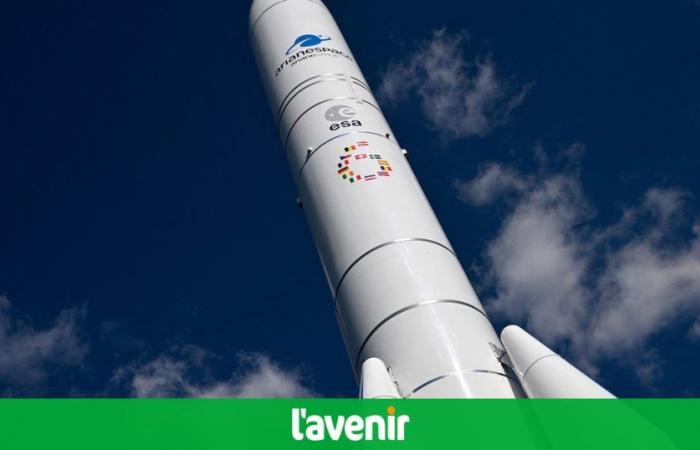Finding the stars to end the crisis and exist in the face of SpaceX: Europe is preparing to launch the Ariane 6 rocket for the first time. Enough to give it back independent access to space, a strategic issue.
On July 9, starting at 8:00 p.m. in Belgium, the European Space Agency (ESA) is to carry out the inaugural launch of the heavy launcher from the Guiana Space Center in Kourou.
A “wet rehearsal” at the end of June, an operation during which all the procedures up to the moment of lighting the rocket’s engines on its launch pad, made it possible to remove the last unknowns.
“It went very well, like clockwork,” says Toni Tolker-Nielsen, ESA’s director of space transportation. “There are no critical points that call into question the launch date.”
Each of the preparatory stages leading up to this inaugural flight has been scrutinised in recent months by European space stakeholders, as the four-year delay in a programme that cost 4.5 billion euros has highlighted European fragility.
Since the last Ariane 5 flight a year ago, Europeans have no longer been able to put a satellite into orbit by themselves: since the invasion of Ukraine, they no longer have access to the Russian Soyuz medium launcher, fired for 10 years from Guyana, and the Vega-C rocket has been grounded since the end of 2022 after an accident.
“Everything that could go wrong has gone wrong,” laments ESA boss Joseph Aschbacher. That is why “Ariane 6 is crucial for Europe, which absolutely must have independent access to space,” he says.
There is no question of missing out on a flourishing space economy – it should represent 822 billion dollars in 10 years, almost two thirds more than today according to the Novaspace firm – or of not being free to act in a context of geopolitical tensions.
Decided in 2014, Ariane 6 will be able to place satellites in geostationary orbit, at an altitude of 36,000 kilometers, like its predecessor Ariane 5, as well as put constellations into orbit a few hundred kilometers from the Earth.
To do this, the upper stage of the rocket has the Vinci engine, which can be reignited in order to drop the satellites at various locations before falling back into the Pacific to avoid leaving more debris in orbit.
While the launcher has already been “qualified” on the ground, the inaugural flight is “a demonstration that all our thermal, mechanical, etc. models work,” explains Toni Tolker-Nielsen. The rocket will carry 18 “passengers,” university microsatellites and scientific experiments.
“This first flight is an important moment for all of us; it is not just the culmination of development efforts, but also the start of the operational phase,” points out Franck Huiban, director of civil programs at Arianegroup, the industrial prime contractor.
The first commercial flight is due to take place at the end of the year and 14 more over the next two years.
“Ariane 5 was designed to go up to 7 launches per year while Ariane 6 was designed to allow 12 launches per year, with a first level at 9 launches” per year, recalls Franck Huiban. Far from the American SpaceX which launched 14 Falcon 9 in May alone.
Not enough to be profitable: ESA member states have agreed to pay up to 340 million euros per year to ensure its economic model from the 16th to the 42nd flight in return for an 11% reduction in costs from manufacturers. The first 15 flights are already financed.
The flight log is already full with 30 missions, including 18 to deploy Amazon’s Kuiper constellation. “This is absolutely unprecedented for a launcher that has not flown,” said Stéphane Israël, head of Arianespace, responsible for marketing and operating the rocket, at the end of June.
A few days before the launch, the operator of European weather satellites, Eumetsat, however cancelled a planned launch on Ariane 6 in favour of SpaceX, citing “exceptional circumstances” without specifying them, ignoring the principle of European preference.
Faced with SpaceX, the challenge for Ariane 6 is to exist in “a market that needs launchers” according to Arianegroup boss Martin Sion, and because it is “the sovereignty launcher of Europe”.
Ariane 6 arrives in a market for medium and heavy space launchers in full transition, marked by the domination of SpaceX and the desire of States to guarantee their own access to space.
These rockets are powerful enough to place geostationary satellites into orbit at an altitude of 36,000 kilometres, while being capable of sending larger loads into low orbits, at a few hundred kilometres, in particular the constellations which will represent 85% of the satellites to be launched by 2032, according to the specialist firm Euroconsult.
Here is an overview of the main heavy-lift launchers competing with the rocket in which the Europeans are placing their hopes.
Ariane 6
The European launcher replaces Ariane 5, which last year carried out the last of its 117 launches in 28 years.
The rocket is available in two versions, depending on whether it carries two or four boosters. Ariane 62, with two boosters, can carry 4.5 tonnes to geostationary orbit (GTO) and 10.3 tonnes to low orbit (LEO), slightly more than the Russian Soyuz launcher.
Ariane 64, for its part, will be able to put 11.5 tonnes into a geostationary orbit and 21.6 tonnes into low orbit. The limit of 20 tonnes in LEO marks the distinction between medium and heavy launchers, according to NASA’s classification.
It will be able to deploy constellations of satellites in different orbits thanks to its relightable Vinci engine, but its main stage will not be reusable, unlike that of the Falcon 9.
Falcon 9
The space industry’s bogeyman has been fired 350 times since its first flight in 2010, including 91 last year, two-thirds of which were to launch SpaceX’s own constellation, Starlink.
Falcon 9 is also used for the US government and NASA, at a high price that allows it to offer lower prices for its other commercial customers, according to its competitor Arianespace.
The rocket can carry 8.3 tonnes to a geostationary transfer orbit and 22.8 tonnes to low orbit.
SpaceX has also developed the Falcon Heavy, capable of placing nearly 27 tons in GTO and 64 tons in low orbit, and is developing Starship, which will be able to carry up to 250 tons in a non-reusable version, SpaceX promises.
NASA chooses SpaceX to develop means of destroying the ISS after 2030
New Glenn, futur mastodonte ?
After years of delays, the first flight of Blue Origin’s reusable rocket is scheduled for September 2024, according to NASA, which will be the inaugural customer.
With its 98 meters, compared to 62 for Ariane 6, New Glenn will be able to carry up to 45 tons in low orbit and 13 tons in GTO.
The company founded by Jeff Bezos remains very discreet about its order book, but many flights will be intended to put Amazon’s constellation, Kuiper, into orbit.
Vulcan Centaur
United Launch Alliance (ULA), a joint venture between Boeing and Lockheed Martin, carried out the inaugural launch in January of the rocket that will replace its Atlas V and Delta IV launchers, the rockets preferred by the American authorities for institutional launches.
The launcher, whose engines will be reusable, will be able to have up to 6 boosters depending on the configuration and put up to 27.2 tonnes into low orbit and 15.3 tonnes into GTO.
H3, the new Japanese rocket
Like Ariane 6, development of the Japanese H3 rocket began in 2014. The launcher, which has up to four boosters and a capacity of 6.5 tonnes in GTO, made its first flight in February.
Spectacular rocket engine explosion, new blow for Japanese space agency
Angara-A5
The Russian rocket that is to succeed the aging Proton launcher has encountered development delays and in April only carried out its fourth launch since the first in 2014. The rocket can place 24.5 tonnes into orbit in LEO and 5.4 tonnes in GTO.
Long March 5
Long March 5 is the heavy-lift version of China’s rocket family. It has been fired 12 times since 2016. It has a capacity of 25 tons in low Earth orbit and 14 tons in geostationary transfer orbit.






